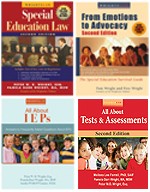What's In Store at Wrightslaw?
![]()
Special Ed Law & Advocacy Training (6.5 hrs)
25% Off the Wrightslaw Bundle of 4 PRINT books for $58.35 (Sorry, coupons not accepted on this product)
Includes Wrightslaw: Special Education Law, 2nd Ed., Wrightslaw: From Emotions to Advocacy, 2nd Ed., Wrightslaw: All About IEPs and Wrightslaw: All About Tests and Assessments, 2nd Ed.
New! The Wrightslaw Bundle is now available as an immediate PDF download. All four Wrightslaw books as PDFs for just $49.95!
![]()
|
Wrightslaw: From Emotions to Advocacy
The Special Education Survival Guide by Pam Wright & Pete Wright |
|
||
The Parent as Expert

"Success
comes before work only in the dictionary." Anon.
The third section of Wrightslaw:
From Emotions to Advocacy is The Parent as Expert. As
a parent, you negotiate with the school on your child’s behalf.
To negotiate, you need information about:
-
Your child’s disability
-
How your child learns and needs to be taught
- How to measure your child's progress
- How to write SMART IEPs
Resources by Chapter
In Chapter 8, you learn about evaluations and your child's disability. See FAQs about your child's evaluation and how to work with educational consultants and independent evaluators.
Bookmark the Getting Help page for our Resource Directories and visit the Yellow Pages for Kids with Disabilities.
Download free publications about IEPs, special education, mental health, transition, reading instruction, harassment, high stakes testing, and discipline from the Wrightslaw Free Pubs page. The Free Pubs page also has a list of free newsletters about special education and advocacy issues.
In Chapter 9, you learn how to organize your child's file. Learn how to format your Master Document List.
Download Sample Master Document List Download Sample Exhibit List
Chapter
10 and Chapter 11
teach you about tests
and measurements. You learn about the bell curve, percentile
ranks and standard scores, composite scores, and subtest scatter. You
learn how to use pre- and post-tests to measure your child’s progress.
When you analyze your child’s test scores, you can develop an appropriate
program for your child.
Confused
about assessment terms? Download this Glossary
of Assessment Terms.
Chapter
12 is about SMART IEPs that are specific, measurable, use
action words, are realistic, and time-limited.
SMART IEPs use the child's present
levels of academic achievement and functional performance to write clear, measurable
goals, short
term objectives and benchmarks about what your child will learn
and be able to do. Scroll down for IEP checklists.
Download
Chapter 12 about SMART IEPS
Articles
about Documents & Organizing the File
The
Paper Case: Managing Your Child's Documents Under the IDEA by Bob Crabtree,
Esq. If you have kids with special educational needs, you can
be overwhelmed by paperwork in no time. This article teaches you about
the importance of different documents and how to organize them. You
learn about documents that are keepers; education records; documents
you should create and how; tips for consulting with an attorney.
Paper Trails: Documents, Exhibit Lists and Due Process Hearings - Pete Wright describes a systematic, step-by-step approach to organizing and maintaining documents generated in special education litigation from the initial interview through pre-trial preparation.
Do Documents Speak for Themselves? by Brice Palmer. If you examine documents carefully, you are likely to find the theme of your case. Learn to organize documents, recognize common fact-finding blunders, collect all records from all sources, and avoid "case-killer" arguments.
Articles About Tests & Measurements
Understanding Tests and Measurements for the Parent, Advocate and Attorney. To write IEP goals and objectives that are tailored to the child's unique needs, you need to learn how to interpret educational and psychological test results. (NOTE: To ensure that you get the graphics in this article, you may want to print the article from the screen, rather than download it.) You will learn about the Bell Curve, standard scores, percentile ranks, composite scores, subtest scatter, norm and criterion referenced tests. Get article
Articles
About IEPs
What
is Your IEP IQ? Take this quiz to test your knowledge of IEPs.
We will send you the answers by email.
Wrightslaw Game Plan: How to Write IEP Goals and Objectives. Parents and teachers ask for help with IEP goals and objectives. In this article, you learn that you must analyze the child's unique needs that result from the disability - and begin with the present levels of performance.
How to Write Measurable Annual Goals. Memorandum from Nissan Bar-Lev, special ed director, that describes the process of writing clear, measurable IEP goals.
How to Make Annual Goals Measurable: Examples and Tips. Remember that "measurable" means you can count it or observe it. Article uses common goals, shows why they aren't clear or measurable, and how to make them clear and measurable.
How to Use a Parent IEP Attachment. Confused at IEP meetings? Do you find that your questions are not answered? In this article by advocate Judy Bonnell, you learn how to use a simple form to track your requests, the school's response, issues that were resolved and issues that are still on the table.
8 Steps to Better IEP Meetings by Jennifer Bollero, Esq. Mother of child with autism explains why parents need to learn the rules and strategies. When you learn the rules, you reduce the risks when you negotiate for your child. "Your child's IEP should never be a gamble. Know what your goals are and work them. Many roads lead to the same place. Many different cards can win the game."
Transition Goals and Plans in IEPs. Beginning at age 14, the IEP must identify transition service needs. The transition statement includes two components: a statement showing how planned studies (course of study) are related to the student's goals beyond secondary education and a statement of the student's goals beyond secondary education.This memo from special ed director Nissan Bar-Lev shows how to include transition statements in the IEP.
IEP Checklists
Present Levels of Performance Checklist. Key question; purpose; definition; key characteristics; writing strategy.
Annual Goals Checklist. Key question; purpose; definition; key characteristics; writing strategy
IEP Review Checklist. If you are preparing for an IEP meeting, review this checklist.
Related Information
Should
I Allow the School Retain My Child? Advice to a parent's frequently
asked questions about retention - generally, it is not a good idea.
To Promote or
Retain. If you have a child with a disability, you may face
a tough decision - should you allow the school retain your child? Many
schools offer two solutions to children's learning problems - retention
or social promotion - and fail to offer the third "R" - remediation.
Read article
Ending Social Promotion: A Guide for Educators and State and Local Leaders. According to the U. S. Department of Education, neither social promotion nor retention is appropriate for students who do not meet high academic standards. Focuses on accountability and school's responsibility to implement high academic standards for all students.
Free Publications about IEPs & Transition
A
Guide to the Individualized Education Program (2000)
This publication from the U. S. Department of Education describes how
to write IEPs that improve teaching, learning, and educational results.
Includes contents of the IEP; IEP team members; writing the IEP; placement
decisions; implementing the IEP; revising and revising the IEP; resolving
disagreements about the IEP; sample IEP form, information and resources,
the federal regulations for IEPs, and guidance about IEPs. Download
Designing Individualized Education Program (IEP) Transition Plans (2000).
The Individuals with Disabilities Education Act (IDEA) requires schools to prepare students with disabilities for employment and independent living. Transition planning that involves students and their families leads to post-school success and independence. Article describes how to design quality IEP transition plans. Download
Copyright © 1998-2022, Peter W. D. Wright and Pamela Darr Wright. All rights reserved. Contact Us
